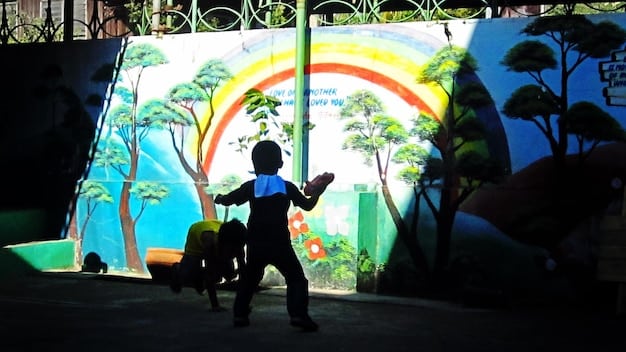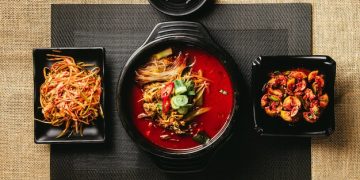K-Drama Fever: How Korean Dramas Promote Culture in the US

K-Dramas’ Global Impact: How Korean Dramas Are Promoting Korean Culture in the US encompasses the remarkable influence of South Korean television dramas in disseminating Korean cultural values, traditions, and lifestyle trends throughout the United States, fostering a deeper understanding and appreciation for Korean heritage among American audiences.
The K-Drama’s Global Impact: How Korean Dramas Are Promoting Korean Culture in the US is undeniable, having woven its way into the American entertainment landscape. These captivating shows not only entertain but also act as cultural ambassadors, introducing viewers to unique facets of Korean life, from its cuisine and fashion to its complex social dynamics and historical narratives. These dramas have created a bridge of understanding and appreciation between cultures.
The Rise of K-Dramas in the US
The surge in popularity of Korean dramas, or K-dramas, in the United States represents a significant shift in the global entertainment landscape. Once a niche interest, K-dramas have now entered the mainstream, captivating a wide audience with their compelling storylines, high production values, and unique cultural perspectives. This rise is fueled by the accessibility of streaming services and social media, which have made it easier than ever for American viewers to discover and engage with Korean content.
Factors Contributing to K-Drama Popularity
Several factors have contributed to the widespread appeal of K-dramas. Their diverse range of genres, from romantic comedies and historical dramas to thrillers and science fiction, ensures there is something for everyone. Additionally, K-dramas often explore universal themes such as love, family, ambition, and social justice, making them relatable to viewers from various cultural backgrounds.
Accessibility and Digital Platforms
The availability of K-dramas on popular streaming platforms like Netflix, Hulu, and Viki has played a crucial role in their increased visibility. These platforms provide subtitles in multiple languages, making the shows accessible to a global audience. Social media has also been instrumental in spreading the word about K-dramas, with fans sharing clips, reviews, and recommendations, creating a vibrant online community.

The accessibility and diverse content of K-dramas have opened doors, allowing American audiences to delve into new countries and cultures without even leaving their homes. The global phenomenon of K-dramas is also a reflection of shifting cultural preferences and a growing interest in diverse and international content.
Cultural Elements Showcased in K-Dramas
K-dramas are rich with cultural elements that offer viewers a glimpse into Korean society, traditions, and values. These elements are woven into the narrative, providing not only entertainment but also education and insight. From the portrayal of family dynamics to the observance of cultural customs, K-dramas act as a window into the Korean way of life.
Family Dynamics and Relationships
Family is a central theme in many K-dramas, reflecting its importance in Korean society. The shows often depict intricate family relationships, highlighting the respect for elders, the importance of filial piety, and the challenges of intergenerational communication. Romantic relationships are also portrayed with a unique Korean sensibility, emphasizing the values of loyalty, commitment, and sacrifice.
Food and Cuisine
Korean cuisine is another prominent feature in K-dramas, showcasing the country’s diverse culinary heritage. Food is often used to express love, friendship, and connection, with characters sharing meals, cooking together, and discussing their favorite dishes. The shows introduce viewers to a variety of Korean dishes, from classic staples like kimchi and bibimbap to more regional specialties.
- Kimchi: A staple in Korean cuisine, often featured in family meals.
- Bibimbap: A mixed rice dish, showcasing a variety of ingredients and flavors.
- Korean BBQ: A social dining experience, emphasizing community and sharing.
Family and food are strong elements, displaying the best qualities of the Korean culture. K-dramas effectively integrate these cultural elements, providing an authentic and engaging experience for viewers, which in turn offers a more relatable feel for American audiences.
Impact on American Perceptions of Korea
The popularity of K-dramas has had a significant impact on American perceptions of Korea. By showcasing the country’s culture, lifestyle, and values, K-dramas have helped to dispel stereotypes and promote a more nuanced and positive image of Korea.
Increased Interest in Korean Language and Travel
Many Americans who watch K-dramas develop an interest in learning the Korean language. Language-learning apps and online courses have seen a surge in popularity, with many users citing K-dramas as their primary motivation. The shows also inspire viewers to travel to Korea, to experience the culture firsthand and visit the locations featured in their favorite dramas.
Cultural Exchange and Understanding
K-dramas facilitate cultural exchange by introducing Americans to Korean customs, traditions, and values. The shows promote understanding and appreciation of Korean culture, fostering empathy and respect. This cultural exchange extends beyond entertainment, influencing fashion, beauty, and lifestyle trends in the United States.

Ultimately, K-dramas have promoted Korea and Korean culture in ways that other forms of entertainment have struggled to do. As Korean culture continues to expand into other facets of the US, more Americans can begin to understand and appreciate another culture.
K-Dramas and the Hallyu Wave
K-dramas are a significant component of the Hallyu Wave, also known as the Korean Wave, which refers to the global popularity of South Korean culture. This phenomenon encompasses music (K-pop), film, television dramas, fashion, and cuisine, all of which have contributed to Korea’s growing cultural influence worldwide.
The Role of K-Dramas in Promoting Hallyu
K-dramas serve as a gateway to other aspects of Korean culture. Viewers who are initially drawn to the captivating storylines and characters often develop an interest in K-pop, Korean fashion, and Korean food. This interconnectedness helps to promote Hallyu as a whole, creating a synergistic effect that amplifies Korea’s cultural influence.
Global Reach and Influence
The Hallyu Wave has reached far beyond Asia, making a significant impact in the Americas, Europe, and the Middle East. K-dramas have played a crucial role in this global expansion, attracting a diverse audience and creating a worldwide community of fans. The cultural exchange facilitated by Hallyu promotes understanding, appreciation, and collaboration between different cultures.
The Hallyu Wave is more than just a cultural phenomenon. It has served as a strong unifier in global culture, allowing for countries to come together, and has allowed smaller countries like South Korea to make a big splash.
Challenges and Criticisms
Despite their popularity and positive impact, K-dramas also face challenges and criticisms. Some critics argue that the shows can perpetuate unrealistic beauty standards, reinforce traditional gender roles, or promote consumerism. Others raise concerns about cultural appropriation and the potential for misrepresentation of Korean culture.
Addressing Stereotypes and Promoting Authenticity
It is important for K-dramas to address stereotypes and promote authenticity in their storytelling. The shows should strive to present a diverse range of characters and perspectives, avoiding harmful clichés and stereotypes. Collaboration with cultural consultants and experts can help ensure that the portrayal of Korean culture is accurate and respectful.
Promoting Diversity and Inclusion
K-dramas should also promote diversity and inclusion, both on and off screen. The shows should feature characters from different ethnic backgrounds, sexual orientations, and socioeconomic classes, reflecting the diversity of Korean society. Additionally, the industry should strive to create more opportunities for underrepresented groups in writing, directing, and acting.
Even so, at the end of the day, K-dramas offer an avenue for various cultures to begin to connect with each other. Of course, these should be taken with a grain of salt, but these issues of globalization have been apparent long before K-dramas came around.
The Future of K-Dramas in the US
The future of K-dramas in the United States appears bright. As the popularity of Korean culture continues to grow, K-dramas are poised to become an even more integral part of the American entertainment landscape. The shows are constantly evolving, incorporating new genres, experimenting with innovative storytelling techniques, and adapting to the changing preferences of global audiences.
Innovation and Adaptation
To stay relevant and engaging, K-dramas must continue to innovate and adapt. The shows should explore new themes, experiment with different formats, and embrace emerging technologies. Collaboration between Korean and American creatives can also lead to exciting new projects that bridge the gap between cultures.
Continued Cultural Exchange
The continued cultural exchange between Korea and the United States will play a crucial role in the future of K-dramas. By fostering understanding, appreciation, and collaboration, both countries can benefit from the vibrant and diverse entertainment landscape. K-dramas have the power to unite people from different backgrounds, promoting empathy, respect, and global citizenship.
The future of K-dramas continues to evolve. With innovation and collaboration, people around the world can begin to connect with each other over shared cultural themes and stories.
| Key Point | Brief Description |
|---|---|
| 🎬 Cultural Showcase | K-dramas display Korean traditions, values, and lifestyle, increasing understanding. |
| 🍜 Food Integration | Korean cuisine features heavily, introducing viewers to dishes like kimchi and bibimbap. |
| 🌍 Global Influence | Part of the Hallyu Wave, K-dramas enhance Korea’s worldwide cultural impact. |
| 🗣️ Language Interest | Increased interest in learning Korean due to K-drama exposure. |
Frequently Asked Questions (FAQs)
K-dramas are popular due to their compelling storylines, unique cultural insights, high production quality, and diverse genres, appealing to a broad audience in the US.
They showcase Korean traditions, cuisine, values, and lifestyle, embedding cultural elements into their narratives, thus educating and attracting the audience.
Family dynamics, food, relationships, fashion, and historical events. Many dramas highlight various facets of Korean tradition and daily life.
The Hallyu Wave is the global spread of Korean culture. K-dramas are a key element, driving interest in K-pop, food, fashion, and language.
More innovation and adaptation, plus collaborations between Korean and American creatives. There will be continued cultural exchange, further popularizing the shows.
Conclusion
In conclusion, **K-Drama’s Global Impact: How Korean Dramas Are Promoting Korean Culture in the US** is undeniable, providing Americans with an engaging window into Korean society, traditions, and values. As part of the broader Hallyu Wave, K-dramas are set to continue shaping cultural perceptions and fostering stronger cross-cultural connections between the United States and South Korea.





